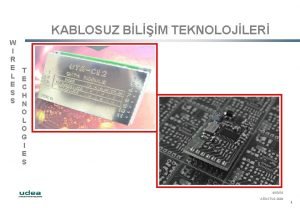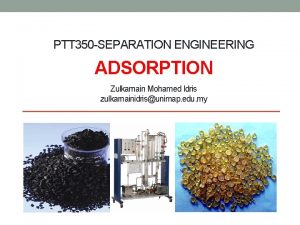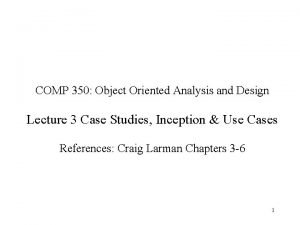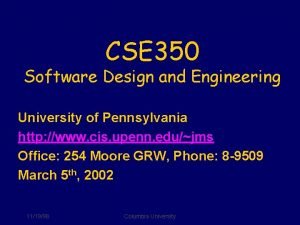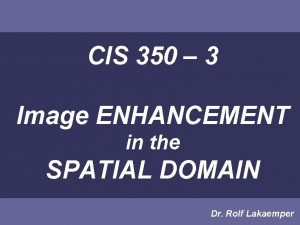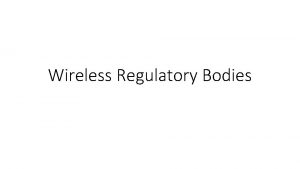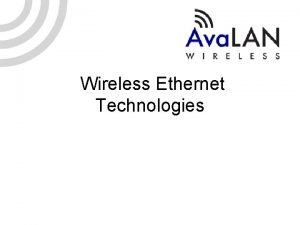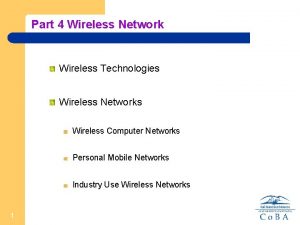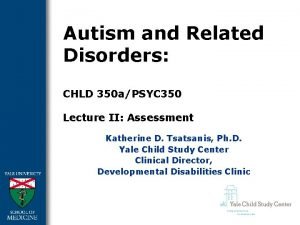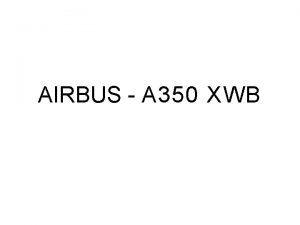CS 350 Chapter12 Wireless Technologies Wireless Agencies Standards










- Slides: 10

CS 350 Chapter-12 Wireless Technologies

Wireless Agencies & Standards Agency Purpose Web Site Institute of Electrical and Creates and maintains Electronics Engineers (IEEE) operational standards www. ieee. org Federal Communications Commission (FCC) Regulates the use of wireless devices in the U. S. www. fcc. gov European Telecommunications Standards Institute (ETSi) Chartered to produce common standards in Europe www. etsi. org Wi-Fi Alliance Promotes and tests for WLAN interoperability www. wi-fi. com WLAN Association (WLANA) Educates and raises consumer awareness regarding WLANS www. wlana. org

Unlicensed Bands Released by FCC Industrial, Scientific and Medical (ISM) 900 MHz 2. 4 GHz Unlicensed National Information Infrastructure (UNII) 5 GHz

The 802. 11 Standards Committee Purpose IEEE 802. 11 a 54 Mbps, 5 GHz standard IEEE 802. 11 b Enhancements to 802. 11 to support 5. 5 Mbps and 11 Mbps IEEE 802. 11 c Bridge operation procedures; included in the IEEE 802. 1 D standard IEEE 802. 11 d International roaming extensions IEEE 802. 11 e Quality of service IEEE 802. 11 F Inter-Access Point Protocol IEEE 802. 11 g 54 Mbps, 2. 4 GHz standard (backward compatible with 802. 11 b) IEEE 802. 11 h Dynamic Frequency Selection (DFS) and Transmit Power Control (TPC) at 5 GHz IEEE 802. 11 i Enhanced security IEEE 802. 11 j Extensions for Japan and U. S. public safety IEEE 802. 11 k Radio resource measurement enhancements IEEE 802. 11 m Maintenance of the standard; odds and ends IEEE 802. 11 n Higher throughput improvements using multiple input, multiple output (MIMO) antennas IEEE 802. 11 p Wireless Access for the Vehicular Environment (WAVE) IEEE 802. 11 r Fast roaming IEEE 802. 11 s Extended service set mesh networking IEEE 802. 11 T Wireless Performance Prediction (WPP) IEEE 802. 11 u Internetworking with non-802 networks (cellular, for example) IEEE 802. 11 v Wireless network management IEEE 802. 11 w Protected management frames IEEE 802. 11 y 3650– 3700 operation in the United States



Wireless LAN Modulation Techniques Direct-Sequence Spread Spectrum (DSSS) 802. 11, 802. 11 b Differential Binary Phase Shift Keying (DBPSK) for 1 Mbps DSSS Differential Quadrature Phase Shift Keying (DQPSK) for 2 Mbps DSSS Complementary Code Keying (CCK) for 5. 5 Mbps and 11 Mbps The three are compatible and can coexist by 802. 11 standard using rate-switching procedure Error can be corrected by a redundant bit

Wireless LAN Modulation Techniques Frequency-Hopping Spread Spectrum (FHSS) No offered by any vendor Orthogonal Frequency Division Multiplexing (OFDM) 802. 11 a/g 52 carriers BPSK or QPSK

Wireless Network Components Wireless Access Points (AP) Wireless Network Interface Card (NIC) Wireless Antennas Omni directional Directional or Yagi d. Bd : 7 d. Bd = 7 + 2. 2 d. Bi

Installing a Wireless Network Ad hoc Mode: Independent Basic Service Set (IBSS) Infrastructure Mode: Basic Service Set (BSS) Security Set Identifier (SSID) – identify a network Extended Service Set (ESS) - extend coverage than a single access point

